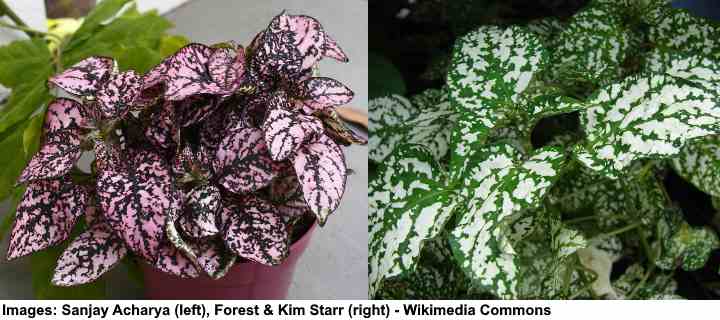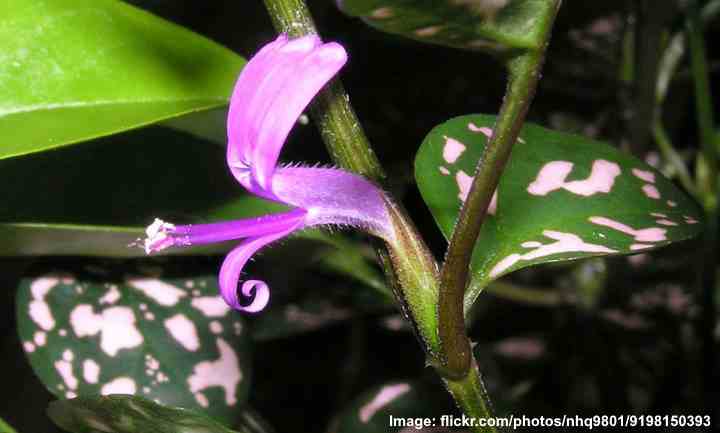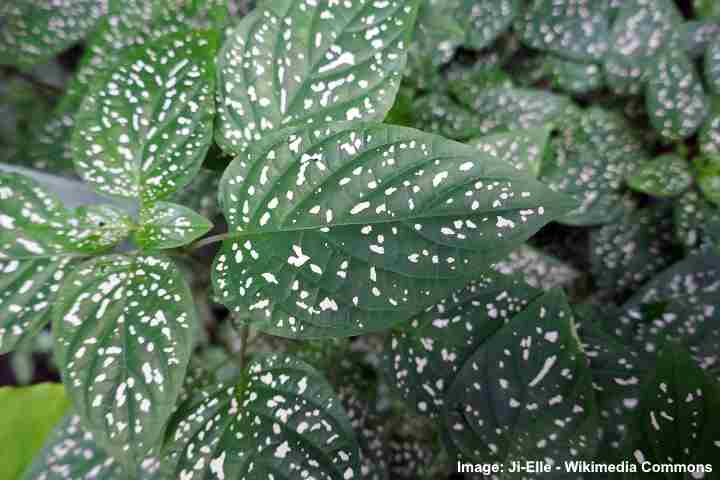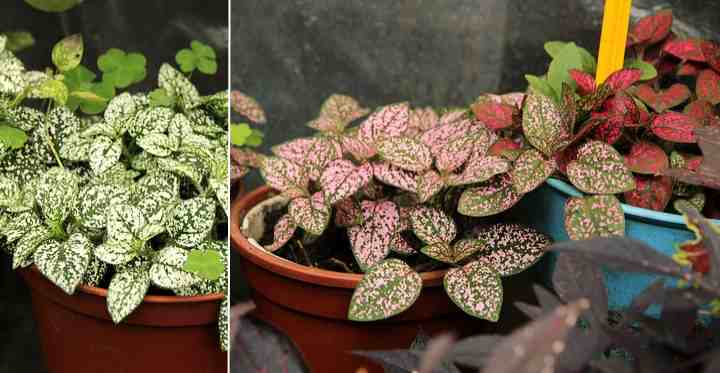Polka dot plants are gorgeous houseplants with pink, white, red, or light green foliage that create a splash of color. Any space or garden will be brightened up by the polka dot designs on the little plants’ leaves. All polka dot houseplant types are simple to maintain indoors, and in the right setting, outdoors, making it a popular kind of plant.
Hypoestes phyllostachya, the scientific name for the polka dot plant, belongs to the Acanthaceae family of plants. The pointed end of the ovate-shaped leaves is referred to by part of the Latin name, which means “with a leaf spike.” Polka dots come in over a hundred different colors and patterns and are found throughout the world.
Freckle face plant and splash plant are two other common names for the polka dot plant. Confetti, pink splashing, and white splashing are some of the descriptive names for certain types of polka dot plants. It’s simple to see how polka dot plant leaves get their name when you see photographs of them.
How to care for polka dot plant (Hypoestes Phyllostachya): Provide adequate humidity and bright indirect light to your polka dot plant in well-draining soil. In typical home temperatures of 70 to 75°F (21 to 23°C), polka dot plants flourish. In the spring and summer, feed your Hypoestes Phyllostachya plant once a month to help it thrive indoors.

Hypoestes Plants
Polka dot plants are tiny and shrub-like in appearance and originate from Madagascar, South Africa, and Southeast Asia. Due to their ornamental value, Hypoestes plants make excellent indoor plants. The most popular color is pink polka dot, which has pink splashes on green leaves.
Hypoestes leaves have freckled dots on some of them. Some designs feature vivid patterns that resemble spray-painted leaves. Red and green polka dots, as well as white and green polka dots, are available in several cultivars.
If you reside in warm regions, you may quickly develop strikingly colorful polka dot plants to enliven your yard. In colder climates, the polka dot (splash) plant flowers as an attention-grabbing blooming annual plant. The lovely colorful freckled foliage is complemented by small pink or purple flowers.
Learn how to care for pink, red, white, and green polka dot plants by reading on. You’ll also discover how to grow these little spotted-leaf houseplants and what to do if your polka dot withers.
Polka Dot Plant (Pink Splash Plant)

The primary attraction of growing this lovely houseplant is the vivid spotted, freckled, marbled, and splashed patterns on polka dot plant leaves. A 3 ft. (90 cm) polka dot plant grows outdoors and reaches maturity. As a border, ground cover plant, or to add color in a huge planter, the colorful speckled leaves are appealing.
Splash plants may grow to be 4″ to 20″ (10 – 50 cm) when grown as an colorful indoor houseplant. Your plant will grow spotted leaves with pink, white, or red colors if you provide it with the care it needs. Polka dot plants with freckled or marbled leaves in various hues are available as well.
Polka Dot Plant (Freckle Face Plant) Flowers

Indoor and outdoor types of polka dot plant bloom, and they don’t just provide a lot of color with their patterned bright leaves, they also create flowers. The plant’s beauty is further enhanced by the attractive perennial blooms set against speckled leaves. What do polka dot flowers look like when they’re in bloom? Little and tubular-shaped, the blooms are tiny. Blue, lavender, pink, or purple blooms are common.
You should usually pinch off the flowers when your polka dot starts to bloom. After blooming, freckle face and splash plants frequently start to die. To avoid your polka dot becoming leggy, pinching some of the branches is also required.
Polka Dot Plant Care (Hypoestes Care)

Despite the fact that polka dot plants are on the list of houseplants that require little care, here are a few tips to help them thrive. Your splash plant will stay bushy and attractive if you take proper care of it.
You can grow a plant from cuttings and Polkadot plants are easy to grow indoors. Now, let’s take a closer look at how to care for your Hypoestes phyllostachya plant.
Lighting Requirements for Pink Splash Plant

To maintain the bright pink, red, white, or green splash patterns on the leaves, indirect sunlight is best for polka dot plant care. Polka dot plants may also be kept in indirect light and will maintain their color. Yet, to maintain their freckled or speckled patterns, they need bright conditions.
Lighting problems are the most common cause of a pink splash plant’s loss of color. The colorful patches and marbling patterns will begin to fade if your splash plant is in a low-light or dark location. Additionally, if your splash plant is in direct sunlight for too long, it might lose its color.
What Soil Do Polka Dot Plants (Hypoestes) Need?

A polka dot plant thrives in rich, well-draining soil. Plant it in moist soil. Using soil with a high quantity of organic matter and a porous blend is one way to get healthy polka dot plants.
Your freckle face plant gets plenty of nutrients from having rich soil. You’ll need warm, moist soil if you’re starting a polka dot plant from seed. Between 70 and 75°F (21 – 23°C) is the optimum temperature for polka dot plant seed to germinate.
Cuttings are the simplest way to cultivate any Hypoestes variety of plants. Peat moss is the type of soil you’ll want for growing polka dot cuttings. Wait until the plant has healthy roots before you water it. After that, you may move your bright plant to polka dot-themed soil.
How to Water Your Polka Dot (Splash Plant)

Your polka dot plant requires just a little watering to survive in the photograph: Hypoestes phyllostachya ‘Red Splash Select.’ The speckled pink or white leaves normally droop or seem unwell as a result of watering problems. Wait until the top part of the soil has dried out to water your polka dot plant. It’s the ideal time to water your plant when the top 1″ (2.5 cm) is dry. To avoid damaging the polka-dotted leaves, always water the soil, not the leaves.
Allow the water to drain out of the bottom of the pot while watering this attractive indoor plant. Root rot is prevented by not allowing the splash plant to sit in water. If the stems start to wilt, that’s one indication that your polka dot plant needs watering. Your drooping polka dot plant will usually benefit from watering thoroughly.
Watering your polka dot plant according to pot size is another tip when caring for a healthy polka dot plant. Little pots are often used to house indoor splash plants. In comparison to large containers, these will dry out quicker. Monitor soil moisture levels on a regular basis if you have a diverse collection of polka dot plants in various hues.
Feeding Your Polka Dot Plant

If you give your polka dot plant enough fertilizer, it will grow healthy and develop a Pink Splash Select appearance. Use a liquid houseplant feed once a month throughout the spring and summer, when growth is greatest. All of the essential micronutrients for your beautiful plant should be provided by this kind of fertilizer.
Feed your polka dot plant less throughout the fall and winter. Every other month should be enough for most fertilization. If your splash plant stops producing leaves in the winter, you should stop feeding it.
Right Growing Conditions for Your Hypoestes Phyllostachya Plant

Polka dot plants are ideal indoor plants because they grow in tropical and subtropical climates. Temperature and humidity are the two most important aspects for maintaining a polka dot plant. A healthy, developing polka dot plant thrives in temperatures of 75°F (23 – 24°C). Indoors, though, at temperatures as low as 60°F (16°C), your polka dot plant should thrive.
Make sure there is enough humidity to ensure you have the perfect environment for freckle face plants. The best method to ensure adequate moisture for the leaves is to mist them daily. When the central heating is on or your room has a dry environment, this misting is particularly essential. Polka dot plants thrive in warm, humid environments.
How to Propagate and Repot a Polka Dot (Splash Plant)

Polka dot plants may be propagated and developed from cuttings with minimal effort. Great gifts for any friend include growing houseplants with pink and green, white and green, or red and green leaves. Cuttings are the best way to propagate polka dot plants. About 5″ (13 cm) from the top, cut off a stem. Just below the stem node should be cut. Place the cutting in a rooting mixture like peat moss or a glass of water after removing the lower leaves.
Roots may take some time to develop, so patience is required. Transplant to a small pot with rich organic matter when your roots are at least 1″ (2.5 cm) long. Place your splash plant in a sunny location and thoroughly water it.
Varieties of Hypoestes Phyllostachya
The list of stunning multicolored foliage plants goes on and on. There is virtually no end to it. The green leaves have varied patterns created by bright, vibrant specks, dots, splashes, blotches, and marbling effects. White-green, light pink-green, and pale rose-green colors may be seen on some of the brighter types of polka dot plants. Burgundy red-green, dark red-green, or various hues of green cover the leaves of darker types of polka plants. To be on the lookout for, here are a few of the most well-known Hypoestes cultivars:
- Polka dot ‘Camina’ The leaves are ovate and pointed, with carmine red splashes on dark green.
- ‘Pink Splash’ polka dot It has light pink dotted patterns and is one of the most popular species.
- ‘Confetti Blush’ freckle face plant The leaves have intricate patterns and are olive-green with white veins. Other varieties of polka dot plants in red, pink, and rose hues with mottled designs are available.
- Wit polka dot plants Colored patterns have a marbling effect. They may vary in color from white to pink to dark crimson-red.
- Pink Brocade Because of the distinctive brocade sort of designs, polka dot houseplants are called that. Pink spots are the most popular variety, but colored leaves come in a variety of hues.
Polka Dot Plant Toxicity for Cats and Dogs
Polka dot plants (Hypoestes phyllostachya) are non-poisonous and won’t harm your pets.
Growing Polka Dot Plant Outdoors (Hypoestes)
If you want to cultivate in your garden, polka dot plants are the perfect variety since they have lovely colorful leaves. While the blooms aren’t spectacular, they can’t compete with the gorgeous foliage, which is why it’s a blooming plant. Polka dot plants are grown as annuals outdoors in a variety of colors. Several nations with warm summers allow polka dot plants to flourish due to the warm climate.
Polka dots grow to be up to 3 feet (90 cm) tall in the wild. Crop varieties, on the other hand, are smaller in size in the garden. A glossy bushy shrub with pink, white, red, or purple speckled leaves may be created by regular pruning. For raising a polka dot shrub outdoors, consider the following advice:
Organic-rich soil that drains well is the finest kind of soil for cultivating polka dot plants in your garden. Roots rot is a condition that can occur if the plant is in a spot where water collects. Polka dot plants thrive in temperatures of 70 to 75°F (21 to 27°C) when growing outdoors.
It’s ideal to grow polka dot plants in containers or pots and bring them indoors if you have chilly winters with below-60°F (16°C) temperatures. Place your polka dots in full sun and partial shade in a well-lit area.
Polka Dot Plant (Splash Plant) Is Leggy
A growth habit of becoming leggy exists in all types of polka dot plants. The long straggling stems can give the little plant a scruffy appearance, despite the fact that pink-green, white-green, or red-green leaves are generally lovely. To avoid your splash plant becoming leggy, what can you do? First, make sure your plant receives enough sunlight. The colorful leaves will stay vibrant and not get leggy if there is enough light. Pinching back the leaves helps prevent your polka dot from becoming leggy.
When the top of the plant begins to produce leaves, simply pinch them off. Should you pinch off the leaves every time? During the growing season, about once a week is sufficient. This will help your colorful plant get used to living in a tiny container as a bushy shrub.
Pruning, on the other hand, typically entails cutting a big number of stems or trimming a plant back. Light pinching once a week is all you need to keep your polka dot looking nice.
How to Revive a Dying Polka Dot Plant
Polka dot plants are tolerant of dry or wet soil, yet they are vulnerable to both. The most common reason why your polka dot plant is dying is because it isn’t watered properly.
Water the plant thoroughly to help it come back to life if the soil has completely dried. Watering should be enough to drain via holes in the bottom of the container. Water the soil on a regular basis until the top half to one inch (1.2 to 2.5 cm) is dry.
A polka dot plant may also die as a result of allowing it to stand in water. Without being saturated, keep the soil moist. Therefore, don’t put small houseplant pots in a saucer of water. Blooming seems to coincide with the death of a polka dot plant, according to several houseplant enthusiasts.
Therefore, prevent the plant from wilting and dying by pinching off any new flowers that appear. The flowers don’t contribute to the plant’s ornamental value because the foliage is so colorful.
